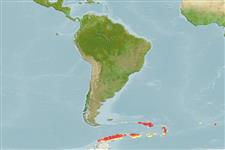Environment: milieu / climate zone / depth range / distribution range
Ecologia
marinhas demersal; intervalo de profundidade 5 - 770 m. Polar; 53°S - 65°S, 67°W - 4°E
Southern Ocean: in the vicinity of Bouvet Island, Scotia Sea, and northern part of the Antarctic Peninsula.
Length at first maturity / Tamanho / Peso / Idade
Maturity: Lm 44.9 range ? - ? cm
Max length : 72.0 cm TL macho/indeterminado; (Ref. 4883); common length : 50.0 cm TL macho/indeterminado; (Ref. 2805); peso máx. Publicado: 3.7 kg (Ref. 4883)
Adults feed mostly on fish and krill. Synchronous spawner (Ref. 50743). Larvae have a long pelagic phase (Ref. 71843). Utilized as a food fish (Ref. 4931).
There is only one generation of oocytes in the ovaries indicative of determinate fecundity (Ref. 50743). Mature females may spawn for the first time from around 6-8 years of age (Ref. 71843).
Hureau, J.-C., 1985. Channichthyidae. p. 261-277. In W. Fischer and J.C. Hureau (eds.) FAO species identification sheets for fishery purposes. Southern Ocean (Fishing areas 48, 58 and 88). Rome. Vol. 2. (Ref. 2805)
Categoria na Lista Vermelha da IUCN (Ref. 130435)
Ameaça para o homem
Harmless
Utilização humana
Pescarias: pouco comercial
Ferramentas
Relatórios especiais
Descarregue XML
Fontes da internet
Estimates based on models
Preferred temperature (Ref.
123201): -1.3 - 1.6, mean 0 °C (based on 42 cells).
Phylogenetic diversity index (Ref.
82804): PD
50 = 1.0000 [Uniqueness, from 0.5 = low to 2.0 = high].
Bayesian length-weight: a=0.00091 (0.00077 - 0.00107), b=3.49 (3.44 - 3.54), in cm total length, based on LWR estimates for this species (Ref.
93245).
Nível Trófico (Ref.
69278): 3.4 ±0.2 se; based on diet studies.
Resiliência (Ref.
120179): Médio, tempo mínimo de duplicação da população 1,4 - 4,4 anos (K=0.17-0.24; Fec = 7,358).
Fishing Vulnerability (Ref.
59153): Moderate to high vulnerability (54 of 100).
Climate Vulnerability (Ref.
125649): High to very high vulnerability (75 of 100).
Nutrients (Ref.
124155): Calcium = 24.2 [13.5, 53.3] mg/100g; Iron = 0.45 [0.19, 0.91] mg/100g; Protein = 17.3 [15.2, 19.4] %; Omega3 = 0.23 [0.12, 0.43] g/100g; Selenium = 23.3 [9.2, 53.9] μg/100g; VitaminA = 10.8 [2.2, 52.1] μg/100g; Zinc = 0.364 [0.235, 0.556] mg/100g (wet weight); based on
nutrient studies.
